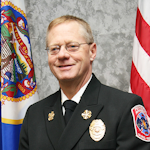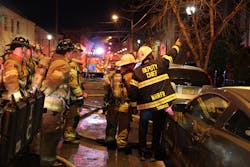As fire service professionals, we examine the factors that contribute to firefighter line-of-duty deaths (LODDs) in an effort to apply lessons learned and prevent reoccurrence. When we take a careful look at investigative reports from LODDs during fire combat operations, we find some disturbing trends related to assessing the fireground for initial operations, determining the operational mode, and deploying our personnel accordingly. Miscalculating the dynamics of the fireground and related staffing requirements places our personnel at a greater and unwarranted risk, sometimes resulting in tragic consequences.
The three rules
It is no wonder that we struggle with decision-making in highly stressful situations. Fire officers are constantly required to make critical time-sensitive decisions with a high degree of accuracy based upon little information in a matter of seconds. Decisions are made based on incomplete and often inaccurate feedback, often resulting in a failed risk-benefit analysis. Our tendency to act quickly and make decisions based upon what’s worked in the past often can get us in trouble. This, coupled with our natural emotional response when making emergent decisions, hinders our ability to remain safe while maintaining an aggressive approach.
This is where tactical discipline comes into play. Tactical discipline is a fireground decision standard based upon an analysis of three rules that the fireground commander should consider in the emergent setting: on-scene staffing, combat intelligence and “science” in determining strategic and tactical decision-making options. It involves selecting the appropriate strategy, identifying the “right” operational mode and deploying personnel to accomplish the incident priorities. Although the tactical discipline doctrine requires a rational, calculated approach to decision-making, it does not mean that it takes more time. Rather, it is an ongoing assessment of fireground dynamics.
Let’s now review each of the three components of tactical discipline.
Tactical Discipline Rule #1: Staffing
Staffing determines tactics, not the other way around. Successful fire suppression activities require a coordinated and concurrent approach to task assignment and completion. Assigning fireground tasks has historically been predicated upon prioritizing fireground duties based on life safety and fire control. When we arrive with too few personnel to accomplish both physically demanding and time-sensitive tasks, we will often resort to pushing the tactical envelope. We place our people in situations in which they are unsupported and understaffed to safely and effectively complete their assignment.
In its landmark 2010 study, Report on Residential Fireground Field Experiment, the National Institute of Standards and Technology (NIST) quantified that the timely and successful completion of critical fireground tasks is directly related to the number of firefighters assigned to the task. Fire modeling conducted for the NIST residential fireground study demonstrated that “a two-person crew cannot complete essential fireground tasks in time to rescue occupants without subjecting them to increasingly toxic atmosphere” (NIST, p.11).
Given the choice, limited crews should be assigned to tasks that will have the greatest impact on successful incident outcomes. When arriving with understaffed companies, it is often wiser to “buy-time” and perform functions that support suppression and rescue operations. When the rest of the assignment arrives, reassign and redeploy your resources based upon need.
Modifying tactical priorities based upon on-scene resources may be prudent when on-scene staffing cannot commit to simultaneous task assignments. This may mean that you re-order the traditionally accepted order of tactical priorities: rescue, exposure, confinement, extinguishment, overhaul, with ventilation considered. For example, putting the fire out before conducting search may be the best choice when considering on-scene resources and firefighter safety.
Many of our age-old tactics are being questioned for the modern fireground, and this is especially true when operating understaffed. Research conducted by Underwriter Laboratories (UL) and NIST support the use of large volumes of water applied to the fire as soon as possible from a safe position to reduce thermal temperatures. Placing large volumes of water on the fire will often take care of the problem and allow companies additional time to make effective searches. This early application of water tactic, combined with managed ventilation (i.e., control the ventilation flow path in a planned, coordinated and communicated manner), is proving to increase the survivability of civilians and firefighters alike.
Bottom line: Don’t overcommit your on-scene resources. If you don’t have enough on-scene personnel to accomplish multiple tasks, limit your task assignments to those that can make the most difference. The ability to implement an effective fireground risk management plan directly influences the survivability of our firefighters.
Tactical Discipline Rule #2: Combat Intelligence
Combat intelligence is much more than a size-up, requiring the fireground commander to step back and make calculated decisions based upon current information and, more importantly, to predict where the event is headed. It requires the fireground commander to actively gather data through their senses. This combat intelligence of the fireground comprises everything we know about the event and response, and then we can initiate an action based upon a well thought-out plan. This is especially true of the first five minutes of activity and early decision-making.
Tactical discipline means that sometimes we don’t rush in with a “damn the torpedoes, full-speed ahead” approach, but instead, we exercise patience and base our actions on what we know, our resources, fire conditions and conducting a realistic victim survival profile. This measured response requires discipline on the part of the responder. Aggressiveness is reserved for when we can truly make a positive difference in lives and property saved. Our rational approach doesn’t mean we are any less aggressive, and it doesn’t mean delaying time-sensitive decisions.
Central to knowing your enemy, it is important to understand what is burning—and how the modern fireground has changed. Unfortunately, we continue to apply tactics developed in the 1800s to today’s 21st-century fires. I’m not suggesting that we throw out our tried-and-true tactics of interior fire attack, but we often fail to recognize the challenges of the “new” fireground.
One component that has dramatically changed is how the box is constructed, its design and contents, and the resulting impact upon fire dynamics and behavior. The exclusive use of lightweight building materials that often support longer spans (load) drastically reduces the amount of burn-through time and promotes early structural collapse. The old “20-minute rule” no longer applies; we can expect early catastrophic structural failure at a quarter of the time when compared to our old standard involving legacy construction.
Fires on the modern fireground burn much hotter, reaching untenable conditions much earlier, with toxic gases and smoke reaching incapacitating concentrations when compared to legacy-type construction and furnishings. Modern, open building concepts, loaded with synthetic furnishings, contribute to rapid fire spread. Today’s fires produce dense volumes of toxic and flammable gases produced at lower temperatures than seen in previous years. And we now know that smoke is fuel.
Informed decisions are based upon the constant flow of cues and clues that bombard the fireground commander. The novice commander may struggle with the amount and speed that information is received. At times, there is too much information to gather, process and make sense of. According to Situational Awareness for Emergency Personnel (Gasaway, 2013), the “experienced” commanders are generally better at understanding the meaningfulness of the data, especially as it applies to identifying options and predicting future needs.
Whenever feasible, knowing the enemy begins with the walk-around (360). If a walk-around is not feasible, have another company perform this critical combat intelligence-gathering task. At times, the fireground commander will need to show poise under pressure and hold off the troops from what may seem as a no-brainer tactical decision. Completing the walk-around provides an opportunity to receive and process as many cues and clues as possible, allowing the commander to comprehend the scale and scope of current and future actions. Again, do not determine your operational mode or commit your troops before conducting a walk-around. Photos A and B show the importance of this critical information gathering.
Determining an occupant survival profile must be one of our first considerations when determining our tactical approach to the fireground. This vital decision addresses what level of risk we are willing to assume and for what benefit. Is this a go- or no-go event in terms of conducting search and rescue as an initial tactical priority?
The decision to “go” and attempt a search is predicated on many different variables that include existing and predicted fire conditions, complexity of getting rescuers to the occupant, available staff to search and conduct concurrent operations, and elapsed time. Our firefighters are often at greatest risk early into the event when conducting search and rescue tasks. The potential to save people should dominate our decision. The question to ask is, “Is anyone alive in there?”—not “Is anyone in there?”
Further, flashover often occurs as the first companies are arriving. The window of opportunity to search and rescue savable victims has been drastically reduced from previous years. Tactical discipline requires that the decision to immediately conduct search and rescue be based upon a rapid assessment of on-scene resources, elapsed time, and conditions. In some cases, search and rescue must be delayed until we can halt or reduce the fire, improving the conditions for both victims and rescuers. During the initial size-up, the fireground commander must decide if occupant survival is probable in the fire compartment and adjacent areas. Often, the best course of action is to control the fire to allow a better chance of survival for the occupants.
Tactical Discipline Rule #3: Science
Science is offering new insight into fire growth, behavior and the impact of these dynamics on structural components. Recent scientific findings provide a much-needed explanation of 21st-century fire dynamics. Most acknowledge the fact the modern fireground has changed over the past 20 years. What we don't fully comprehend is why this has occurred. Fortunately, research conducted by several notable organizations has helped address this question. Incorporating these research findings into our daily toolbox of strategies and tactics should be a priority of all fire service leaders.
Research conducted by UL and NIST has altered many of our long-held tactical beliefs. The idea of “pushing” the fire has been demonstrated to be false when fires streams are applied correctly. We’ve spoken about the “resetting” of the fire taking care of the problem and allowing companies additional time to make effective searches. Further, an alarming trend in LODDs prompted research into the influences of ventilation and the control of ventilation flow paths to reduce flashover. UL research into the performance of building materials under fire conditions as well as understanding the limitations of the thermal imager in basement fires has led to additional tactical approach considerations.
Reduce the risk
Tactical discipline is an art that requires competence, maturity and restraint on the part of the fireground commander. Deployment of fire companies in today’s fire environment must be made with an equal dose of science, knowledge, experience and on-scene resources. Risk is reduced to our firefighters when we take a measured and calculated approach during fireground decision-making.
References
Gasaway, R.B. (2013). Situational Awareness for Emergency Personnel. Tulsa, OK: PennWell Corporation.
National Institute of Standards and Technology (NIST-2010). Report on Residential Fireground Field Experiments (NIST Technical Note 1661). Washington, D.C.: U.S. Government Printing Office.

Richard Kline
RICHARD C. KLINE is a 40-year fire service veteran who recently retired from the Plymouth, MN, Fire Department, following 23 years of service as fire chief. He is a frequent regional and national speaker who covers topics that relate to command competencies and firefighter safety and health. Kline can be contacted at [email protected].






